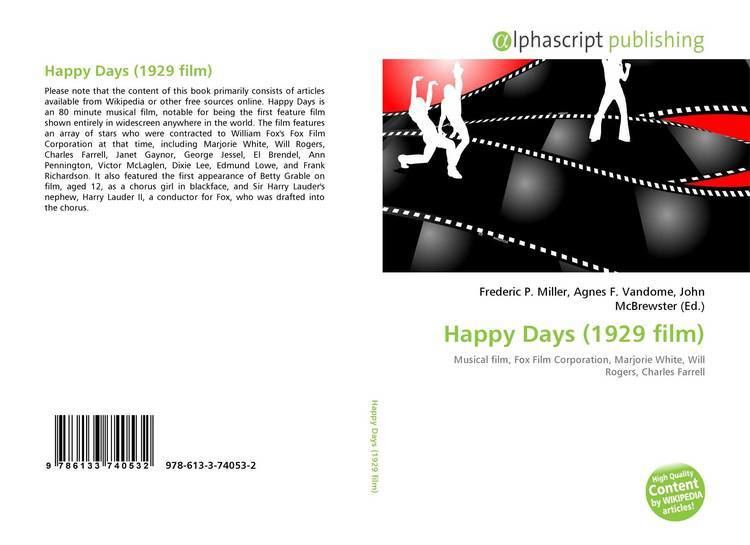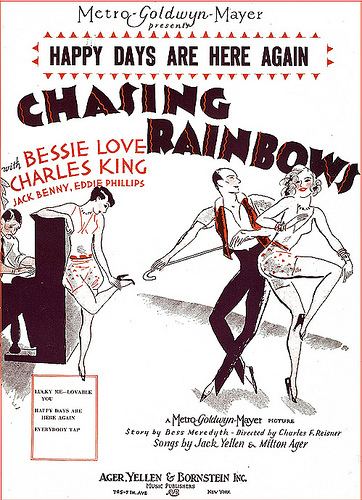Happy Days (1929 film)
7.2 /10 1 Votes
Language English | 7/10 IMDb Genre Musical Duration Country United States | |||||||||||||||||||||||||||||||||
 | ||||||||||||||||||||||||||||||||||
Release date September 17, 1929 (1929-09-17) (preview)February 13, 1930 (1930-02-13) Cinematography John G. Schmitz, Lucien Andriot Cast Charles E. Evans (Colonel Billy Batcher), (Margie), Richard Keene (Dick), (Jig), Martha Lee Sparks (Nancy Lee), Clifford Dempsey (Sheriff Benton)Similar movies Marjorie White appears in Happy Days and New Movietone Follies of 1930 | ||||||||||||||||||||||||||||||||||
Annette hanshaw happy days are here again 1930
Happy Days is a 1929 American Pre-Code musical film, notable for being the first feature film shown entirely in widescreen anywhere in the world, filmed in the Fox Grandeur 70 mm process. French director Abel Gance's Napoléon (1927) had a final widescreen segment in what Gance called Polyvision. In 1927, Paramount released Old Ironsides with two sequences in a widescreen process called "Magnascope". In 1928, MGM released Trail of '98 in a widescreen process called "Fanthom Screen".
Contents
- Annette hanshaw happy days are here again 1930
- Ben selvin his orchestra happy days are here again 1930
- Plot
- Release
- References

The film features an array of stars who were contracted to William Fox's Fox Film Corporation at that time, including Marjorie White, Will Rogers, Charles Farrell, Janet Gaynor, George Jessel, El Brendel, Ann Pennington, Victor McLaglen, Dixie Lee, Edmund Lowe, and Frank Richardson. It also featured the first appearance of Betty Grable on film, aged 12, as a chorus girl, and Sir Harry Lauder's nephew, Harry Lauder II, a conductor for Fox, who was drafted into the chorus.

Ben selvin his orchestra happy days are here again 1930
Plot
Originally titled New Orleans Frolic, the story centers around Margie (played by Marjorie White), a singer on a showboat who, when she hears that the showboat is in financial trouble, travels to New York City in an effort to persuade all the boat's former stars to perform in a show to rescue it. She is successful and the stars all fly to New Orleans to surprise the showboat's owner, Colonel Billy Blacher, with a grand show, the proceeds of which will go to rescue the showboat.
Release
After a preview on September 17, 1929, Happy Days premiered at the Roxy Theater in New York City on February 13, 1930 with a Niagara Falls widescreen short on a Grandeur screen of 42x20 ft, compared to the standard 24x18 ft screen. It was also shown in Grandeur at the Carthay Circle Theatre in Los Angeles, from February 28, 1930.
At a screening at the Roxy Theater, film critic Mordaunt Hall praised the cinematography, which was noted to be enhanced by the wider format. However, he regarded the film itself as "... not one that gives as full a conception of the possibilities as future films of this type will probably do."
Due to the Great Depression few movie theaters invested in widescreen equipment and the format was abandoned until 23 years later. Fox Film Corporation's heavy investment in Grandeur technology led to William Fox losing his business, which was eventually merged in 1935 with Twentieth Century Pictures to form 20th Century Fox. No widescreen print of Happy Days is known to survive.
References
Happy Days (1929 film) WikipediaHappy Days (1929 film) IMDb Happy Days (1929 film) themoviedb.org
